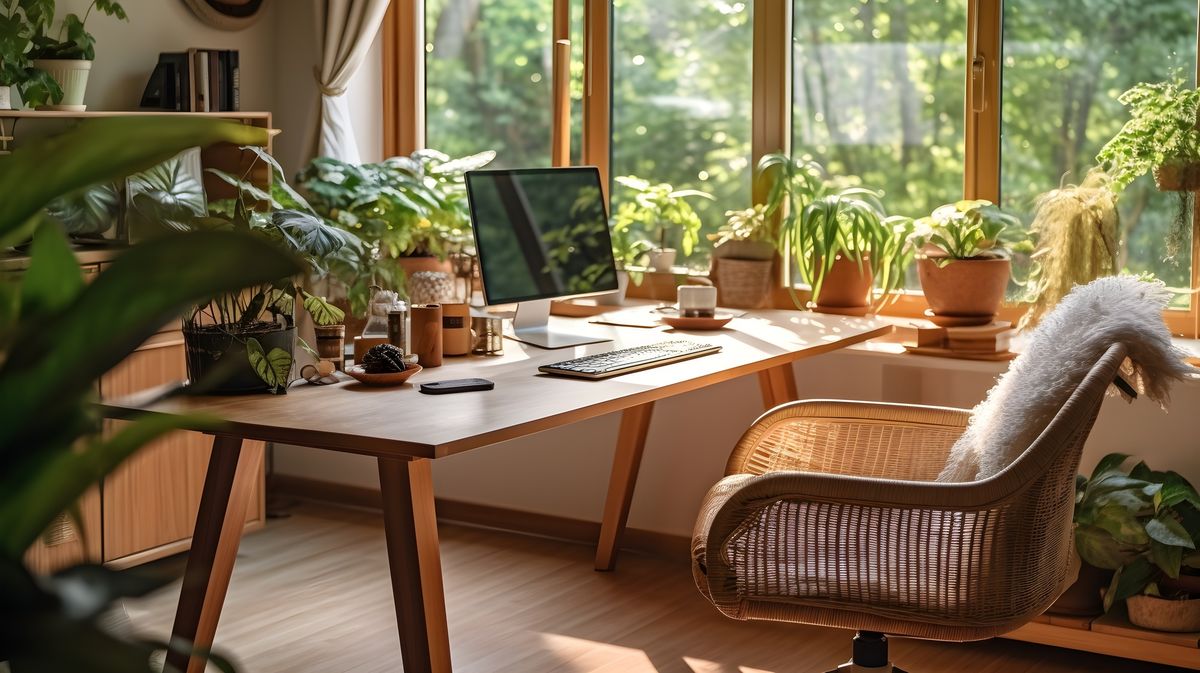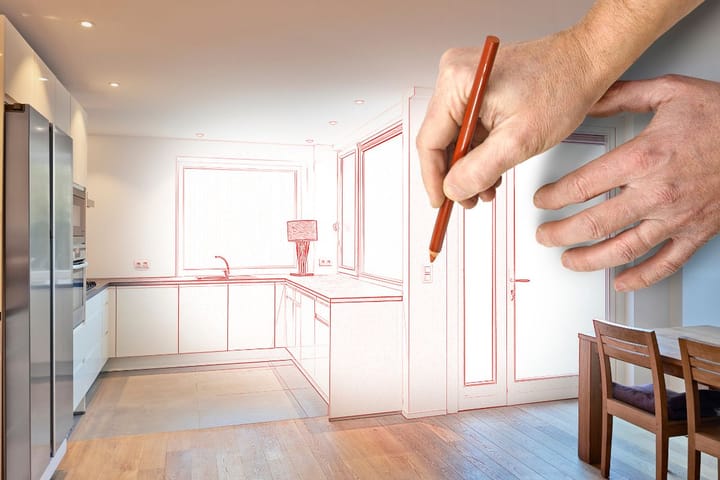A Complete Guide To Building A Healthier Home Workspace
Remote work is now commonplace, offering adaptability but also posing unique workspace health challenges. Ensure a conducive and ergonomic home setup.

Working from home has become the new norm for many people. While it offers flexibility and convenience, it also presents challenges, especially when it comes to maintaining a healthy workspace.
Ideally, your home office should prioritize functionality, productivity, and comfort to help you achieve optimal performance with minimal distractions. By doing so, you can create a workspace that allows you to perform your best work while promoting your overall well-being.
The Benefits of Building a Healthy Home Workspace

Creating a healthier home workspace offers a multitude of benefits that extend beyond the immediate comfort and productivity gains. Here's why investing time and effort into optimizing your workspace is a wise decision:
- Improved Physical Health
Among the benefits you can get from a properly designed workspace with ergonomic furniture is that it reduces your risk of developing musculoskeletal issues like back pain, neck strain, and carpal tunnel syndrome. By prioritizing ergonomics, you're taking proactive steps to safeguard your physical health.
- Enhanced Mental Well-being
A well-lit, organized, and personalized workspace can positively impact your mental health. For instance, natural light and a clutter-free environment can reduce stress and boost your mood. On the other hand, adding personal touches like plants or artwork can make your workspace feel more inviting and pleasant.
- Increased Productivity
A healthy home workspace promotes better focus and concentration. When you're comfortable and free from distractions, you can be more efficient and complete tasks more quickly. This increased productivity can lead to a better work-life balance.
- Better Work-Life Integration
Creating a dedicated and appealing home workspace helps establish boundaries between work and personal life. This separation is crucial for maintaining a healthy work-life balance. When you step into your workspace, you're in "work mode," and when you leave, you can switch off and relax.
Overall, a healthy workspace can safeguard your physical and mental health, improve productivity, and create a positive work environment.
Building A Healthier Workspace: Your Guide And Tips
So, how do you build a healthier home workspace? Here is a complete guide to help you navigate the process, from ergonomics to lighting and everything in between.
1. Ergonomics: Your Foundation for Comfort
The foundation of a healthier home workspace lies in ergonomics. After all, proper ergonomics can help prevent discomfort and musculoskeletal issues. Here's how to achieve it:
- Invest in an Adjustable Desk
An adjustable, standing desk lets you switch between sitting and standing positions effortlessly. This dynamic approach to work can significantly reduce the tension on your shoulders, neck, and back. With an adjustable desk, you're no longer confined to a sedentary posture, promoting better circulation and preventing the stiffness that often accompanies long hours at a desk.
- Ergonomic Chair Selection
An ergonomic chair provides crucial support and promotes a neutral posture, making it an indispensable piece of furniture for anyone working remotely. One of the main functions of an ergonomic chair is to provide proper lumbar support. The lower back naturally curves inward, and a chair with adjustable lumbar support helps maintain this curve, reducing the risk of lower back pain and strain.
Most ergonomic chairs also feature high-quality padding and breathable materials to ensure comfort. With proper cushioning, you can reduce pressure points and enhance your overall comfort, allowing you to focus on your work without discomfort or distractions.
- Proper Keyboard and Mouse Placement
The proper placement of your keyboard and mouse is often overlooked, yet it plays a pivotal role in preventing discomfort and promoting productivity. When these input devices are positioned correctly, your wrists, forearms, and shoulders remain in a natural and relaxed posture, reducing the risk of repetitive strain injuries (RSIs) like carpal tunnel syndrome.
However, even with proper keyboard and mouse placement, it's essential to take short breaks and perform stretching exercises for your wrists, forearms, and shoulders. These breaks can help relieve muscle tension and promote blood circulation.
2. Lighting: Illuminate Your Productivity
Effective lighting is essential for productivity and reducing eye strain. Here's how to light up your workspace:
- Natural Light Maximization
The impact of natural light on your mood and mental well-being is undeniable. For one, sunlight stimulates the release of serotonin, a neurotransmitter that boosts feelings of happiness and reduces stress and anxiety.
That said, by embracing natural light and placing your workspace near a window, you can create a more uplifting and soothing environment, fostering a positive mindset and enabling you to work with greater focus.
- Install Task Lighting
While natural light provides overall illumination, task lighting, such as desk lamps or adjustable light fixtures, is designed to focus light precisely on the area where you work, read, or perform specific tasks. This versatility ensures that your workspace remains well-lit, regardless of the time of day or the level of natural light available.
3. Organization: Streamline Your Efficiency
A cluttered workspace can often hinder productivity and increase stress. Here are some tips to help you organize your home office efficiently:
- Declutter Regularly
Clutter competes for your attention and can be a constant source of distraction. On the other hand, when your workspace is clutter-free, you can concentrate on your tasks without unnecessary interruptions. So, keep your workspace clean and tidy by regularly going through your belongings and getting rid of things you no longer need.
- Manage Cables
A clutter of cables not only looks messy but can also lead to accidents and hinder your productivity. You can tame the cable chaos by using cable organizers and clips to keep wires tidy and prevent tripping hazards. It's also recommended to use cable labels or cable tags to identify cables at both ends. This makes it easier to trace cables when needed and prevents confusion.
- Get Storage Solutions
Storage solutions are essential for maintaining a healthy and clutter-free home workspace. So, invest in storage solutions like shelves, cabinets, or drawers to keep your supplies and documents organized and within reach.
4. Connectivity: A Seamless Digital Experience
Connectivity is crucial for a seamless digital experience in your home workspace. To create an environment that promotes productivity, it's important to prioritize two key aspects: internet stability and digital organization.
- Internet Stability
In today's digital age, a stable and reliable internet connection is the backbone of any home workspace. A robust internet connection ensures seamless communication, efficient workflow, and access to vital resources. So, make sure your internet connection is stable and fast enough to support video calls and data-heavy tasks. Consider upgrading if necessary.
- Digital Organization
Digital organization is fundamental for maintaining an efficient and productive home workspace. A well-organized digital environment not only boosts productivity but also contributes to reduced stress and enhanced data security, ensuring that your home office remains a hub of efficiency and focus. You can use cloud storage and digital tools to keep your files and documents systematically organized and conveniently accessible from any device.
5. Comfort: Enhance Your Well-being
Creating a comfortable workspace goes beyond ergonomics and encompasses your overall well-being. Here are other factors to consider in enhancing your comfort:
- Temperature Control
A workspace that is too hot or too cold can negatively impact your focus. It can also have adverse effects on your health, causing stress, fatigue, and even physical discomfort.
To create a more comfortable environment, consider using fans, heaters, or thermostats to regulate the temperature according to your preference. This will help ensure you can work in a conducive and comfortable atmosphere, maximizing your overall efficiency.
- Noise Management
Noise disruptions can break your concentration and lead to decreased productivity. In some cases, it can also lead to stress and frustration. Thus, minimize distractions using noise-canceling headphones or white noise machines, especially in a busy household. You can also seal gaps around doors and windows with weatherstripping to reduce outside noise infiltration. With advanced noise cancellation technology, we're Unleashing Pure Sound, allowing you to immerse in crystal-clear audio without distractions.
6. Breaks: Recharge for Productivity
Having regular breaks is crucial for avoiding burnout and staying focused in your home office. Here are a few strategies to help you include breaks in your routine:
- Schedule Breaks
Scheduled breaks are not merely downtime; they are essential for maintaining a healthy and productive home workspace. Taking regular breaks provides an opportunity to recharge, ultimately leading to increased productivity when you resume work. Additionally, breaks play a vital role in reducing mental fatigue, ensuring you can sustain high levels of performance and well-being throughout the day.
A good way to do this is to set a timer to remind yourself to take short breaks every hour. You can use this time to stretch, walk around, or simply relax.
- Have Mindful Moments
Mindful moments are a valuable addition to your home workspace routine, offering a range of benefits, from stress reduction to enhanced focus and well-being. Incorporating mindfulness practices like deep breathing, meditation, mindful eating, gratitude, and stretching can create a workspace that not only supports your work tasks but also nurtures your mental and emotional health. So, practice mindfulness or meditation during breaks to clear your mind and reduce stress.
7. Personalization: Make It Your Own
Personalizing your workspace is a fantastic way to enhance motivation and unleash creativity. Here are ways you can make your workspace truly your own:
- Add Decor and Personal Items
Adding decor and personal items to your home workspace is a creative and meaningful way to make your work environment more comfortable and inspiring. You can add artwork, plants, or personal mementos to your workspace to create an environment that reflects your personality and inspires you. Plus, having these personal items around your workspace can enhance physical comfort during long work hours, promoting your well-being.
- Hang Up Inspirational Quotes
Incorporating inspirational quotes into your home workspace is a simple yet powerful way to boost motivation, focus, and positivity. Quotes have the potential to inspire and remind you of your goals and values throughout your workday. So, hang up motivational quotes or phrases on the wall or on your work desk that resonate with you to keep you focused and positive.
Wrap Up
Building a healthier home workspace isn't just a luxury; it's a necessity for anyone working remotely. The benefits are far-reaching, encompassing physical health, mental well-being, productivity, and work-life balance.
By following the tips and recommendations outlined in this guide, you'll not only create a workspace that maximizes your efficiency but also contributes to your overall quality of life. So, take the time to invest in your home workspace—it's an investment in your health and happiness. Your future self will thank you for it.




Comments ()